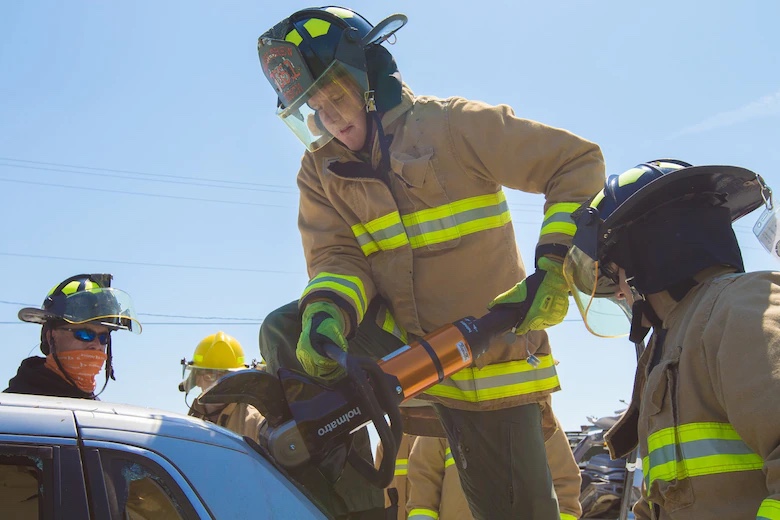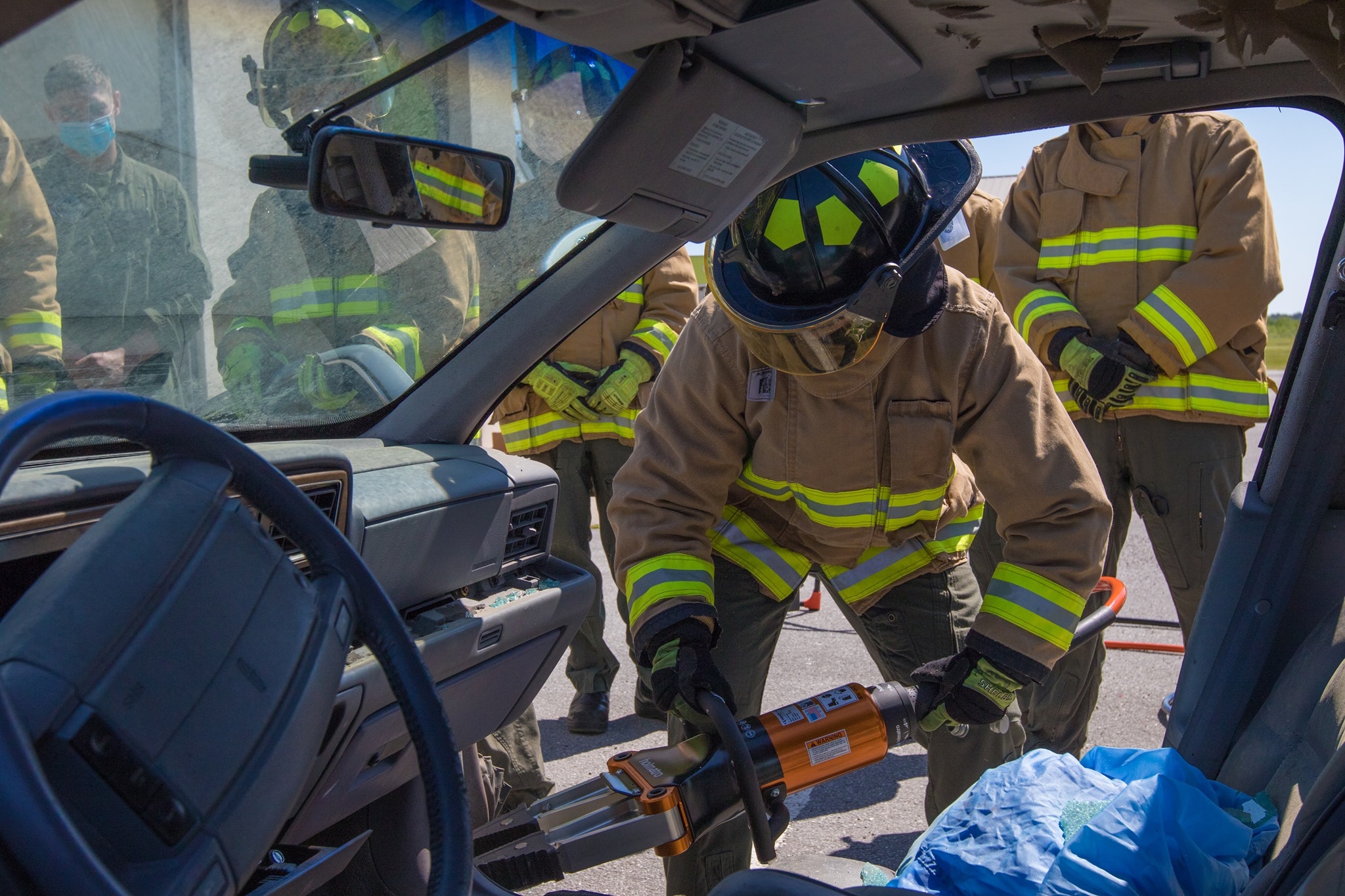MARINE CORPS BASE QUANTICO, Va. —
A new Marine Corps Systems Command program is standardizing and fielding modern, life-saving equipment for Marine Corps firefighters at installations worldwide.
In 2019, MCSC established the Expeditionary Fire and Rescue team. The group is tasked with modernizing and standardizing hydraulic extrication systems to support Marine firefighters at military air stations and installations.

The EFR team falls under MCSC’s Joint Project Manager for Chemical, Biological, Radiological and Nuclear Protection.
“The purpose of Marine Corps Systems Command’s EFR team is to provide equipment to support fire and rescue emergencies, such as crash and fire rescue situations,” said CWO4 Eric Auburg, MCSC’s CBRN deputy. “The team equips Marines with important, life-saving capabilities.”
In April, the group conducted its first-ever fielding of new rescue equipment aboard Marine Corps Base Cherry Point, North Carolina. The tools support Marine firefighters in extricating personnel from air or ground vehicles in emergency situations.
The fielding occurred less than 24 months after the program started—despite the group comprising just two individuals.
“What this two-man team has accomplished in the last two years has been nothing short of incredible,” said Auburg.
Similar to ‘Jaws of Life’
The EFR Hydraulic Extrication Family of Systems are tools that spread, pull and cut into ground vehicles or aircrafts to safely remove individuals from life-threatening situations. The gear includes sheers and extractors as well as a lightweight hydraulic pump used to activate the tools.

The removal devices operate similarly to “Jaws of Life,” used by civilian firefighters.
“These tools are similar to what you might see used by emergency personnel when passing by an automobile accident,” said Auburg. “Our tools can be used during aviation and vehicle mishaps to cut away at a cockpit or ground vehicle in order to remove personnel.”
For example, Marines can wedge a tool called “the spreader” into a pressure point along the vehicle, such as the area between a door and door frame. The Marine can then activate the hydraulic pump, which spreads the steel pieces apart and forces an area to open up.
Ted Salas, a life cycle logistician with EFR team, said the extrication tools are lightweight and man-portable, enabling Marines to carry them while hiking into the forest or up a mountain to reach the emergency site.
The hydraulic pump allows firefighters to simultaneously operate two items. It weighs significantly less than many older pumps used by Marines and can fit into a backpack, said Auburg. The lighter load allows for faster transport during emergency situations.
“These tools are maneuverable and lightweight, helping Marines haul them in confined spaces that trucks cannot pass through,” said Salas. “They incorporate modern technology that eases the workload and weight on Marines.”
This year, the EFR team plans to field the equipment to Marines at military bases in North Carolina, New Jersey, Virginia, South Carolina, California and Arizona. The group will begin fielding overseas by the third quarter of fiscal year 2022.
Salas said the equipment is expected to be fully fielded by fiscal year 2026.
The importance of standardization
The EFR team leveraged commercial off-the shelf equipment designed to be scalable, smaller and lighter while providing a greater capability than the unstandardized, unit-purchased and sustained, legacy extrication equipment of the past.
“Previously, Marines used equipment based on what the unit had purchased,” said Auburg. “Some of that equipment could be anywhere from five years to 20 years old. Some tools could have been brand-new, but it wasn’t standardized across all units.”
The standardization of the EFR equipment not only equips Marines with modern, relevant, life-saving tools, but it also will save the Marine Corps training time and effort. For years, individual units would purchase their own tools for extraction missions and train their Marines to use them.
However, Marines often handle new equipment when moving to a new location, which requires additional training. A set of modern, standardized EFR equipment prevents Marines from having to continuously relearn gear employment.
“Having standardized equipment across the Marine Corps will create a smoother transition for Marines,” said Sgt. Benjamin Alexander, an Expeditionary Firefighting and Rescue Specialist at Marine Corps Air Facility Quantico, Virginia. “Instead of having different types of equipment to teach Marines, you cut that all out and go straight into the same operations.”
Alexander contributes to a team that provides emergency support aboard MCB Quantico. He expressed his excitement and appreciation for the new, modernized EFR equipment, which he believes will be easier to operate than similar tools of the past.
“The newer equipment is more advanced, lighter and easier to carry,” said Alexander. “It’s going to make our jobs much easier.”
A ‘truly remarkable’ effort
The conversation to launch the EFR team started in 2018. The Marine Corps intended to create a program office that could standardize and modernize ERF equipment for Marine firefighters to use locally and abroad, per Auburg.
In FY19, the EFR program began with two core members. Salas is the team’s logistician. Robert Allen, a contractor who spent more than 20 years as a Marine firefighter, serves as EFR’s subject matter expert and program analyst. The team plans to bring in a project officer in the future, said Salas.
Salas said the greatest obstacle the EFR team has encountered was simply starting the program. Much work goes into maintaining an established program, but a new program requires even more work. This meant longer hours in the office.
The truncated nature of their program meant the two team members shouldered all responsibilities, from researching effective solutions, to drafting required documentation, to planning New Equipment Training.
“We started from scratch, creating the paperwork and the presentations to get funding before we even began fielding,” said Salas.
Salas and Allen both have experience as project officers for MCSC, with a sound understanding of the need to continuously coordinate and communicate with each other to create documentation and other tasks to provide effective equipment to Marines.
“It wasn’t an easy task with just two people, but we got it done,” added Salas.
The two spent many hours drafting documentation, soliciting industry proposals, researching effective systems and acquiring the EFR technologies. The culmination of these efforts occurred during the EFR fielding aboard Cherry Point, where the duo attended to verify the tools met expectations.
Allen said Marines so far have responded positively to the equipment.
“The Marines praised the new, modern gear throughout new equipment training,” said Allen. “Their feedback is important to us.”
Auburg commended Salas and Allen for their hard work and dedication despite the disadvantages that come with having a small team.
“A team of two, starting from scratch, went through the bureaucracy of the acquisition process and all the documentation required, which has ultimately resulted in equipment in the hands of Marines less than two years later,” said Auburg. “That is truly remarkable.”
Photo by LCpl Symira Bostic

